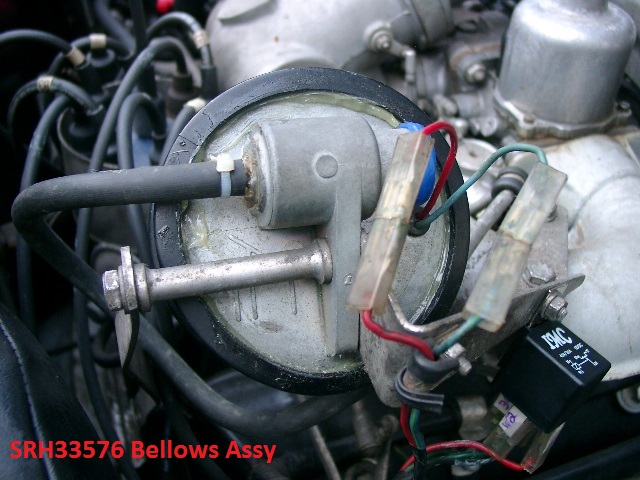| Author | Message | ||
Brian Vogel Grand Master Username: guyslp Post Number: 905 Registered: 6-2009 |
Hello All, While I understand the basic operating principle of cruise control that employs vacuum and a bellows, I really don't have a clue as to the specifics. What follows is strictly a "for my curiosity" set of questions. There's no crisis du jour but I presume that members of the cohort know these systems very well. First, three pictures:    There is only one model year difference between these two cars, although SRH33576 is European spec and LRK37110 is US spec. There's a clear difference in the control of the bellows on these two cars. The former has only one solenoid (I think it's a solenoid) while the latter has two. Referring to the Illustrated Parts Catalog (Section A12, PDF Pages 6 & 7, Amendment 3/Pg1 & Amendment 2, Pg2, respectively) aren't much help at all since they lack a key and don't seem to identify what lies under "the bumps" on the assembly plate as separate parts. A general description of how the bellows is controlled for each style, if someone knows this, would be much appreciated. Brian | ||
John Grieve Experienced User Username: john116 Post Number: 33 Registered: 4-2012 |
My SRH40222 has the same bellows and associated solenoids as your LRK37110. I assume maybe SRH33576 has had a replacement fitted at some point that's slightly different? | ||
Paul Yorke Grand Master Username: paul_yorke Post Number: 1228 Registered: 6-2006 |
One solenoid is an early one. The first solenoid oscillates between vac and atmosphere to maintain the speed. As I remember the second vents to atmosphere when the unit is off as an extra safety device and quicker cut off. | ||
Brian Vogel Grand Master Username: guyslp Post Number: 910 Registered: 6-2009 |
John, The setup in both cars is original and both styles are documented in the spare parts catalog. Paul, Is there a prescribed testing technique for the solenoid itself? I really hate the bellows setup in these cars because they're so leak prone. I've had issues in the past with the cruise control which have been tricky to resolve but have all been due to things like wonky relays. Now I'm suspecting I may have a solenoid malfunction (on the single-solenoid car) and am not quite sure what I should be looking for as far as testing goes. Brian | ||
Paul Yorke Grand Master Username: paul_yorke Post Number: 1229 Registered: 6-2006 |
12v feed and earth I think. Test for feed when it should be engaged. Over 30mph etc Don't do it on the road though :/ | ||
Brian Vogel Grand Master Username: guyslp Post Number: 973 Registered: 6-2009 |
I'm now getting around to testing the speed control bellows mechanism. The workshop manual describes the single solenoid setup as having a red and a blue cable(wire). Of course, mine has a red and a green cable. The testing instructions say to connect the red wire to ground and to apply +12V to the other wire to see if it actuates the bellows and begins to pull on the throttle linkage. However, it also warns, "Incorrect connection of the cables will result in permanent damage to the electronic circuits." Given the above warning, I want to ensure that the red wire/cable is always the one that should be connected to ground during testing or, if it's not, how I should go about determining which wire gets connected to ground and which gets the +12V. If it turns out that the solenoid is not operating correctly, is this thing some common solenoid that is available at a well-stocked auto parts emporium or is it something Crewe created and only Crewe Original sells? Brian |